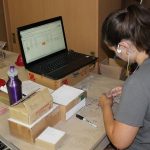Blog posted by Emily Quarato
What’s so Dense about Crystallinity?
This year for the BAKOTA project I am one of two students working on chemistry related topics! Chemistry is becoming widely used in the archaeological field as a means to approaching a problem. The Békés 103 site where we are working deals with many cremated burials thus to the naked eye one would believe not much is left for us as archaeologist to understand, however there is so much that we have yet to uncover! Bone even in its burned state has many underlying properties which can tell us so much about the past.
One of the biggest studies currently on bone relates to the composition and crystallinity. Crystallinity is a term used often in reference to the study of the organization the lattice structures and composition which make up crystals. There have been some studies about crystallinity structure however, the study of its composition is very lacking. Well you may be thinking, it can’t be that understudied, and you would be right, it’s not that understudied but in comparison to crystal
structure it is! And how great it is for me because composition means elements and elements mean chemistry! In combination with compositional studies my interest in bone density has lead me to combine the interest in compositional crystallinity with density to determine if there is a working relationship between the composition of crystallinity in burned human bones and density.
Working with my mentor, Dr. Julia Giblin, and many previously published papers (mostly C. Snoeck papers!) we have come up with a working methods to approach this problem. However, currently most of the work being done in Hungary is in preparation for the work that will be done back in the states in the labs where we have access to more equipment. Based off of previous research we have decided to go with using FTIR-ATR to examine our samples. FTIR-ATR stands for Fourier Transform Infrared Spectroscopy – attenuated total reflectance, which was chosen for its ability to run small amounts of sample which can be analyzed in a short amount of time in comparison to other methods. FTIR-ATR is a machine that works to analyze the crystal structure of the materials placed in it by calculating a difference in light
diffraction patterns sent through the sample. However, in preparation for using the FTIR-ATR back in the United States, I have been collecting plant and bone samples to be tested while in Hungary. For the bone sampling I have collected two calcined bones, one cranial and one post-cranial, and two non-calcined bones, one cranial and one post-cranial from a selected group of burials. For the plant sampling Dr. Giblin, Craig (the other chemistry student working on Ceramic, check out his work/blog for more cool chemistry work!), and I went out into the field to collect samples from grass, shrubs, trees, and shells surrounding the Bekes sites to aid another study of Dr. Giblin’s which is related to mobility and diet of past peoples.
Although I still have a lot of work to do on this project the implications whether there is a correlation between crystallinity and density or not will improve the knowledge about crystallinity, burnt bone, and density. Specifically this project will allow us insight on the understanding on the formation of burnt bone chemically and how that may affect qualitative aspects such as color or fracture patterns. From here I would like to look more into relationships between density and other bone related characteristics as the archaeological field seems to be lacking in its knowledge of bone density related topics!
Here are some fun reference sites that talk more about crystallinity! I have also included the blog for Christophe Snoeck, a researcher who has some very interesting related work!
- http://www.seas.upenn.edu/~chem101/sschem/solidstatechem.html
- http://chsnoeck.wix.com/christophesnoeck


